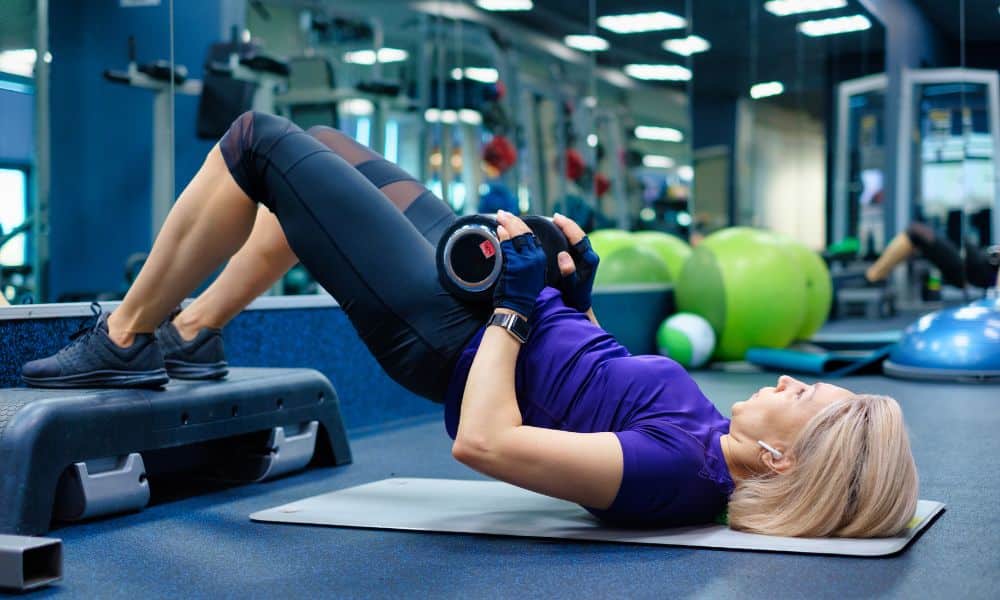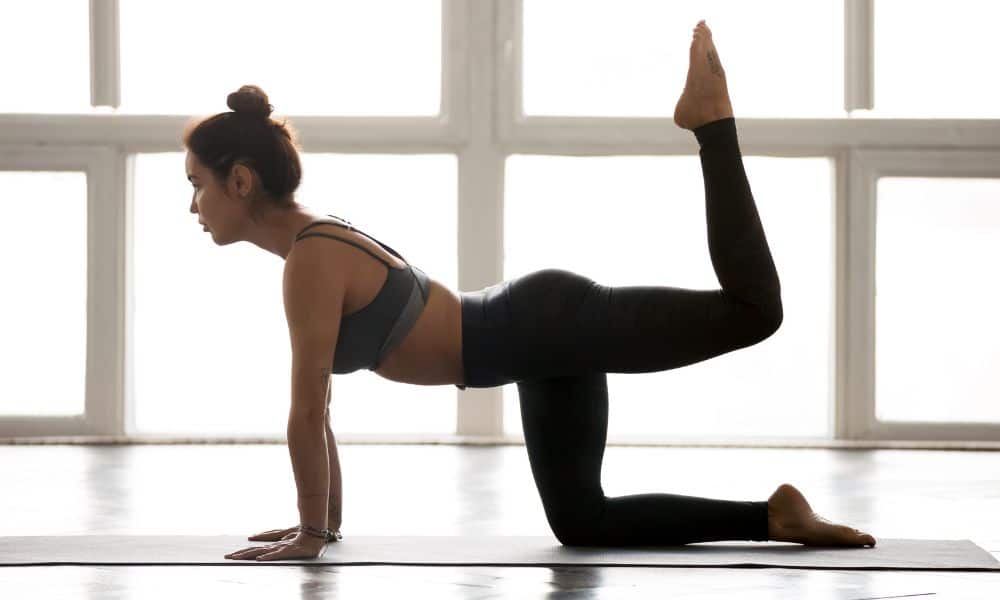The hip thrust is a great exercise to strengthen your glutes, but you should know a few things before you add this to your workout. You’ve seen it on Instagram and maybe even tried it yourself.
First, let’s discuss what makes this exercise so effective and how it can benefit your fitness goals.
What Is a Hip Thrust?
The hip thrust is a great exercise to build strength in the hips and glutes. You can do the hip thrust with or without weights, depending on your fitness level.
To do the hip thrust with no weight: Lie on your back with knees bent, feet flat on the floor, and arms out at your sides for balance if needed. Lift your lower back off the bed so that only your shoulders, head, arms, and heels touch. Squeeze your glutes as you push through them until you’re sitting up straight with your knees bent at 90 degrees (similar to how you would sit when doing a squat). Hold this position for 1-3 seconds before lowering yourself slowly while maintaining tension on those glutes (it should feel like you’re trying to squeeze them together).
What Is a Hip Thrust Machine?
The hip thrust machine is a piece of exercise equipment that allows you to perform the hip thrust, which is an exercise that works your glutes and hamstrings. It’s also known as the glute bridge.
The benefits of using this machine include the following:
- Building stronger glutes and hamstrings with less risk of injury than other exercises like squats or deadlifts (which can put too much pressure on the lower back)
- Being able to use more weight than when doing bodyweight reps (and therefore getting more results from each rep)
Why it is important
If you’re looking to improve your glute strength, the hip thrust is one of the best exercises you can do.
The hip thrust is a single-joint movement that targets the glutes and improves their activation. It also increases glute strength and power by increasing hip extension torque (the amount of force produced at end-range hip extension), which leads to improved performance in sports such as sprinting and jumping.
It also helps develop a balance between your body’s right and left sides since it requires stability throughout all four limbs. This can help prevent injury when performing other exercises like squats or deadlifts.
How to do it
It’s essential to keep your back flat and core tight during the entire movement. You want to feel your glutes squeezing at the top of each repetition. If you can’t, then it’s likely that you are letting your lower back take over as a result of fatigue during the set.
To do this exercise, lie face down on the ground with your feet hip-width apart and arms straight next to your sides (or crossed in front of you). Lift off from this position by pushing through your heels until you form a straight line from shoulders to knees—like someone is holding up all four corners of a tablecloth underneath you—and hold for 1-2 seconds at the top before lowering back down into starting position.
Hip Thrust Sets and Reps
The hip thrust is an exercise that focuses on the gluteus maximus, one of the largest muscles in your body. This muscle helps you stand tall, walk efficiently, and maintain proper posture. In addition, you can do it anywhere—no equipment required!
To perform a hip thrust: Get into position on a bench or other sturdy surface with your feet flat on the floor about shoulder-width apart. Bend forward at the hips so your upper body is nearly parallel to the bottom (or slightly higher). Place one hand against each kneecap for support if needed. Then, with toes pointed toward each other and knees straightened out behind you, focus on contracting your glutes while keeping your core tight and bringing yourself back up to standing by pushing through both heels until they hit the floor again.”
Common Hip Thrust Mistakes
Your hips are too high: If your hips are too high, the gluteus maximus is not activated correctly, and you may feel the exercise in your lower back rather than in your butt. To fix this, keep your chest pressed into the floor by using a pad or towel under it to remind you where it should be during the exercise.
Your shoulders are too low/too high: This can lead to anterior pelvic tilt (the arching of one’s lower back), which increases pressure on the lumbar spine and can cause injury over time if repeated enough times without adequate rest between sets or workouts.
Difference Between a Glute Bridge and a Hip Thrust
A glute bridge is a great, effective hip extensor exercise. It’s one of my favorites because it’s easy to isolate and overload your glutes. But contrary to popular belief, you’ll get better results from the hip thrust if you’re looking to build strength and size in your glutes. The reason is that the hip thrust involves more muscles than just your butt—it also targets your hamstrings and lower back—so there’s more muscle activation overall during this exercise than a glute bridge.
If you’re looking for explosive power or speed on the field or court, doing squats is probably better for building better movement mechanics. But if all you care about are strong muscles, do hip thrusts instead!
Benefits of Hip Thrusts
The hip thrust is a great exercise to add to your workout routine if you want a more muscular butt, better mobility, or the ability to squat more weight. You can also use it for injury prevention by improving your posture and increasing overall strength in your hips, legs, back, and core. The list of benefits is pretty extensive:
To Build Strength
The Hip Thrust exercise is a great way to build strength in your glutes, hamstrings, and lower back. It is a compound exercise that works for multiple muscle groups at once, including the glutes (which are the largest muscles in our bodies), hamstrings (the powers of the back of your legs), and erector spinae (muscles that run along each side of your spine).
Generates More Power
Hip thrusts are a great way to build strength in your glutes and hamstrings, but they also have another significant benefit: power. Power is the ability to rapidly create force, which is what you need when you’re moving with high velocity at an angle (think throwing a football or swinging a baseball bat).
A study of elite American football players showed that hip thrusts generated more power than squats and deadlifts, two of the best exercises for building strength and size. This makes sense because when you perform a hip thrust correctly, all three glute muscles contract simultaneously, even before loading takes place. This means your hips are ready for action from the very beginning!
To Work on Mobility
If you want to get into a good position for other exercises, like the squat or deadlift, then you need to work on your mobility. Hip thrusts are one of the best ways to do this. They also help you improve mobility by lengthening and stretching the muscles in your hips and lower back. This will help you get into a better position during other exercises, making them more accessible and more effective at building muscle mass.
To do this exercise correctly, lie face down on the floor with your feet hip-width apart, toes pointing outwards slightly so that they are turned slightly outwards when looking down as though in an athletic stance. Place hands underneath shoulders with arms straightened out so they’re not crossing over each other but instead tucked underneath each shoulder blade while pushing down gently into them as though trying not to touch them together (this will prevent any unnecessary strain being placed on those joints).
Who Should Do the Hip Thrust?
If you’re new to weightlifting, a beginner, or have never performed this exercise before. Then I would recommend starting with bodyweight hip thrusts. If you’ve been weight training for a while but haven’t done any barbell glute bridge variations, this is an excellent way to incorporate them into your workout routine and build up strength in the glutes with heavy loads. As your glutes become more robust and more efficient from performing the hip thrust exercises consistently, you can then progress on to using resistance bands or dumbbells.
Start by doing two sets of 15 reps at 50% of your max rep range (i.e., if you could do 20 reps at 50%, start doing 10). You don’t want to get into bad habits from too much volume too soon! Once you feel comfortable doing that, increase the weight or add more repetitions until it becomes challenging again.
The Last Word on the Hip Thrust Exercise
We hope we’ve made you a fan of the hip thrust. We know plenty of exercises that promise to improve your glutes, but this is different. It’s an exercise that can help women reduce their risk of injury while building strength and increasing power output and mobility. These benefits make it great for athletes and those who sit at desk jobs all day!
If you or someone you know is considering bodybuilding, share this article on Facebook or Twitter so that others can learn more about building muscle.




